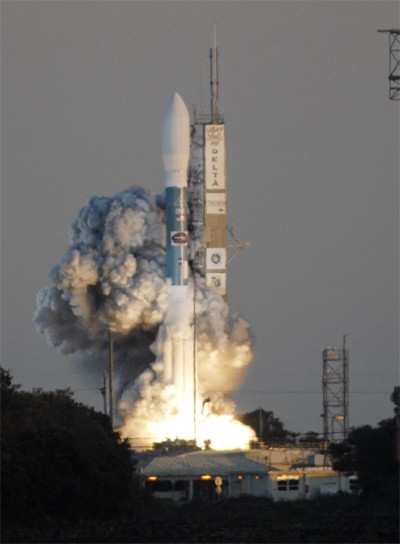Sun, Feb 18, 2007
Aurora Observation Project Underway
Five satellites... one rocket. Just past 6 pm EST Saturday,
NASA's THEMIS mission blasted off from Cape Canaveral Air Force
Station in Florida, racing into space on the flaming power of three
rocket stages and nine solid rocket motor.

Once in proper orbit, the five small satellites comprising the
Time History of Events and Macroscale Interactions during Substorms
(THEMIS) project will disperse around Earth to monitor auroras like
the Northern Lights.
NASA is undertaking the mission to investigate what causes
auroras in the Earth's atmosphere to change in appearance and
dissipate. Discovering why the light of auroras can fluctuate and
fade will provide scientists with important details on how the
planet's protective magnetosphere works and on the sun-Earth
connection.
As Aero-News reported, NASA
originally bumped the launch date to Friday, due to concerns at
Kennedy Space Center about an advancing cold front and the severe
storms accompanying it. The storms remained in the area throughout
Friday, causing stronger-than-acceptable upper-level winds and
resulting in a second 24-hour delay.
Named for the Greek goddess of justice, wisdom and good counsel,
and the guardian of oaths, THEMIS is a mission to investigate what
causes auroras in the Earth's atmosphere to dramatically change
from slowly shimmering waves of light to wildly shifting streaks of
color.
"The THEMIS mission will make a breakthrough in our
understanding of how Earth's magnetosphere stores and releases
energy from the sun and also will demonstrate the tremendous
potential that constellation missions have for space exploration,"
said Vassilis Angelopoulos, THEMIS principal investigator at the
University of California, Berkeley. "THEMIS' unique alignments also
will answer how the sun-Earth interaction is affected by Earth's
bow shock, and how 'killer electrons' at Earth's radiation belts
are accelerated."
NASA states discovering what causes auroras to change will
provide scientists with important details on how the planet's
magnetosphere works and the important Sun-Earth connection.
(Photo courtesy NASA)
More News
Witness Reported The Airplane Was Flying Low And Was In A Left Bank When It Struck The Power Line Analysis: The pilot was on final approach to land when the airplane collided with >[...]
How To Get A Story On Aero-TV News/Feature Programming How do I submit a story idea or lead to Aero-TV? If you would like to submit a story idea or lead, please contact Jim Campbel>[...]
From 2012 (YouTube Edition): A Segment Of The Sport Aviation World That Truly Lives "Low And Slow" Pity the life of ANN's Chief videographer, Nathan Cremisino... shoot the most exc>[...]
Aero Linx: International Business Aviation Council (IBAC) IBAC promotes the growth of business aviation, benefiting all sectors of its industry and in all regions of the world. As >[...]
Execute Missed Approach Instructions issued to a pilot making an instrument approach which means continue inbound to the missed approach point and execute the missed approach proce>[...]
 NTSB Final Report: Cozy Cub
NTSB Final Report: Cozy Cub ANN FAQ: Contributing To Aero-TV
ANN FAQ: Contributing To Aero-TV Classic Aero-TV: Seated On The Edge Of Forever -- A PPC's Bird's Eye View
Classic Aero-TV: Seated On The Edge Of Forever -- A PPC's Bird's Eye View ANN's Daily Aero-Linx (04.29.25)
ANN's Daily Aero-Linx (04.29.25) ANN's Daily Aero-Term (04.29.25): Execute Missed Approach
ANN's Daily Aero-Term (04.29.25): Execute Missed Approach



